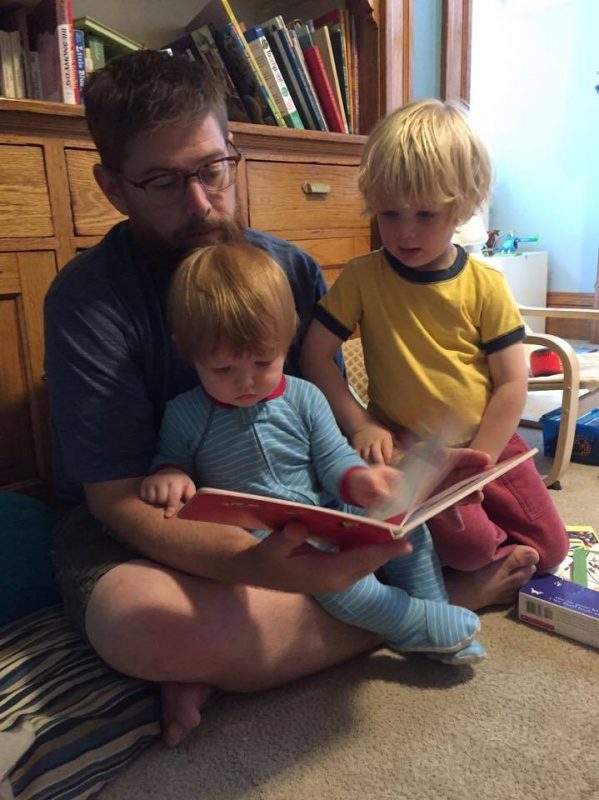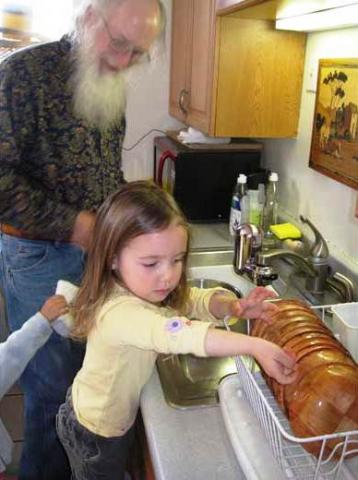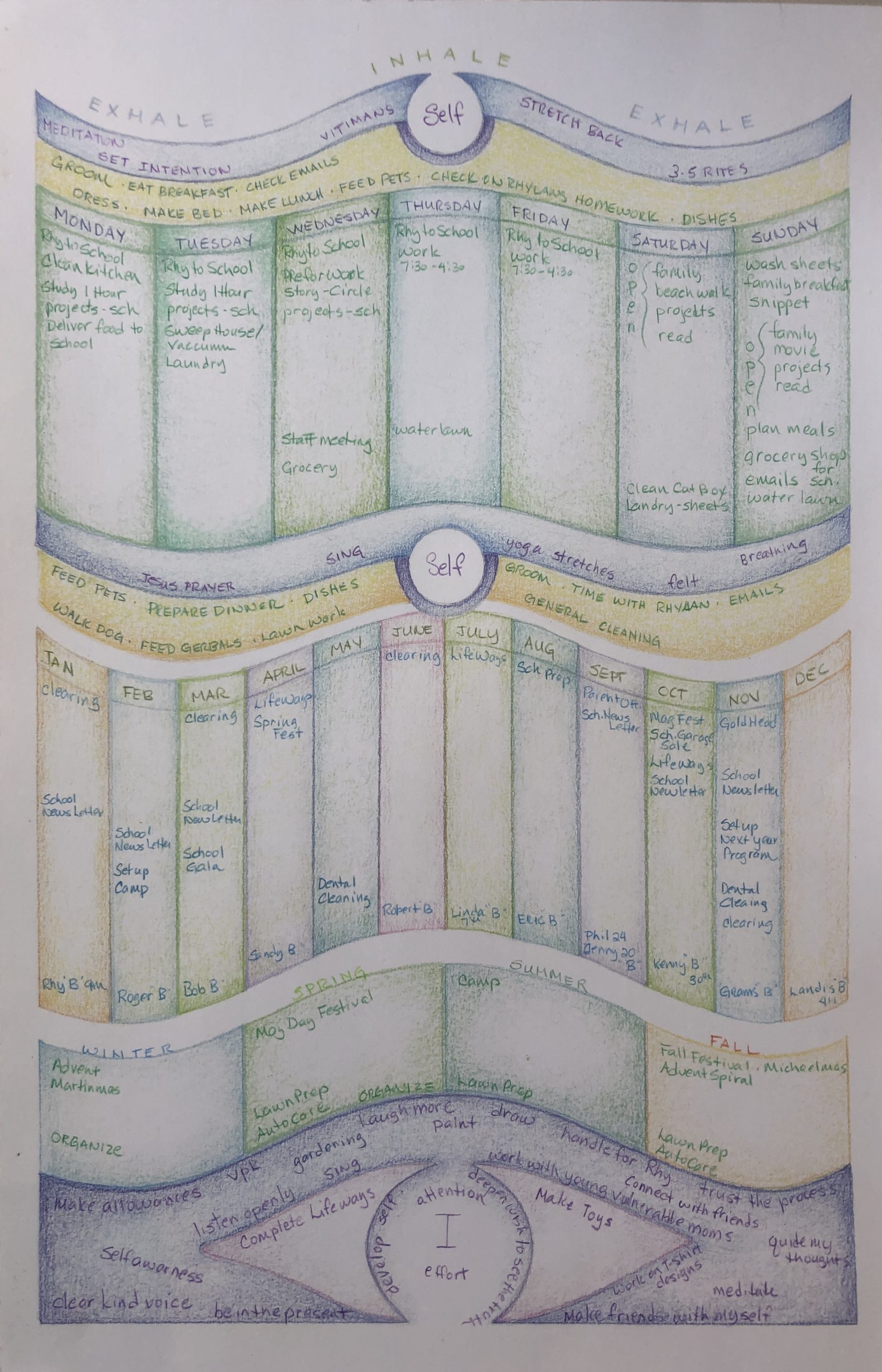April 8, 2020

A Guide to Building a Rhythm at Home
By
Adana Whyte
First, let me confess something. Even though as a young mother, I studied Steiner’s teachings and read You Are Your Child’s First Teacher, which stresses the importance of an at-home rhythm, I had a very hard time sticking to one. With my artsy, freewheeling spirit, I liked to float along, going wherever I wanted. In reflection, I can see that my lack of sequence did not serve my mothering or my coping skills. It was not until I became a LifeWays teacher that I really understood and fell in love with rhythm. Once you have a rhythm in place, the stress of what comes next dissipates and you can actually float along in the way I always thought I was by being artsy and freewheeling.
The internet has a wealth of information to support you but it can be overwhelming to navigate. In this article, I attempt to gather the key points and simplify it for you as you work on your rhythm. I know many of you have already established a rhythm. Perhaps you will find some new inspiration or simply some confidence in this article.
What is Rhythm?
In music, rhythm is what makes the music move and flow. It is made up of sounds and silences and can be like a steady heartbeat for the music. In our bodies, it is the heartbeat, the steady flow of blood, that keeps us alive and in motion. You can think of rhythm of the lifeblood and heartbeat of the day. In your home, rhythm is the daily, weekly, monthly, and seasonal sequence of activities, tasks, and events.
The first thing to know is that is rhythm is not a schedule. In a schedule each activity is separate and should be completed at a set time, focusing on the minute-to-minute. Rhythm is not concerned with what time you do something, only in the order or sequence of the activities.
A Rhythm is built of anchors. What is fixed in a rhythm is not when but what. When building your rhythm, determine the aspects of your day and week that are required (daily: meals, inside time, outside time, rest, work, etc. or weekly: bread baking, painting, laundry, etc.). Place these fixed anchors on a chart and begin filling in around them. You might also consider making a weekly rhythm for meals and snacks. If you and your child both know that on Monday you have rice cakes with sunbutter, you won’t have to think of what to make and they won’t have to think of what they want.
Sample Daily Rhythm
Waking & Dressing
Breakfast
Activity of the Day
Inside Play
Circle or Music Time
Lunch
Story or Book Time
Quiet Rest Time
Outside Time
Cleaning
Dinner
Bedtime
Sample Weekly Rhythm
Monday is watercolor painting day.
Tuesday is coloring or playdough day.
Wednesday is nature walk or gardening day.
Thursday is bread-baking day.
Friday is domestic arts or handwork day.
Saturday is errand day.
Sunday is rest day.

Sounds and Silences, Inhale and Exhale. Like anything alive, a rhythm breathes. In any rhythm there are moments of sound (exhale) and moment of silence (inhale). We need both the expansive moment—the out-breath, where we relate to the external world—and the moment of contraction—the in-breath, where we turn inward and connect with ourselves. When we breathe in we gather our inner resources and refuel our well of strength. Quiet activities such as rest, quiet alone play, yoga, meditation, nature walks, stories, and meals are examples of this inner focus. When we breathe out, we are engaging, exploring, learning, and attending to daily needs. Chores, outside play, social activities, academics, craft activities, and circle time are examples of engaging with the outer world.
In building your rhythm, consider the natural rise and fall of breath, the blending of inner and outer activities. Too much of one and not enough of the other will make the rhythm feel wonky. Don’t stress at the start; go on instinct. When the part of rhythm feels right, it will fall into place and flow naturally. Remember it takes repetition for a rhythm to work, so try it out for a few days before you make big changes. But also, feel free to make big changes and experiment to find what works for your family.
You, the parents, are also anchors of Rhythm. As the adult, you lead the movement into the next activity or event. When it is nearing time for you to transition in the day, begin by giving small signals of the coming change to the child. You might let them know it is “this much time until snack” by pinching your finger close together. When you are ready, consider a song or story that leads into the next activity. This does not and should not always be verbal. You might also signal the coming change with your body. Begin tidying up around the child before you tell them it is time for toys away. Children live in the world of motion and they will feel the change of rhythm in the change of motion around them.
Your energy can have an impact on the tempo of the rhythm. If you are anxious about getting onto the next thing, your child will feel that and the rhythm can start to feel wonky. Rhythm is about knowing that each moment will arrive when it is ready. It is good to let yourself get lost in what you are doing because it feels natural and organic. Sometimes that means your nature walk takes longer than you imagined and that is okay. The laundry can be folded whenever you return. Let yourself sink into the present moment. The rhythm will take care of the future!
Recently a parent asked me, how do I balance the rhythm for my child and caring for the needs of my home and myself? The rhythm is for us and our house. Our children are not separate from the domestic arts. The rhythm is not for us to constantly engage our children. Rather it is for us to engage with our child in the needs of the day. Bring your laundry outside and fold it while your child is encouraged to play in the yard or help you. Let your child wash the table, while you wash the lunch dishes. It is okay for you child to ‘be bored’ and for them to play or work on a project on their own.
First look at your rhythm and make sure you are leaving enough room and not cluttering the day. Keep it simple. You can put some mommy or daddy or grandma time in your daily rhythm. This is also your child’s time. I would recommend have a specific blanket or activity that comes out during your respective times. You might do this after rest time. Set out a blanket and bring out a few dolls or gnomes for your child to create his or her own story. When this time is done, sit down and watch your child’s story.

Why does Rhythm matter for children?
Rhythm is the predictable return of something over time. The way the sun and moon move through the day is a predictable rhythm. The sun will rise in the east, climb through the sky, and then set in the west. The moon goes through its phases over the course of the month. Spring comes. Then summer. Then the leaves fall for autumn, and finally, we arrive again in the chill of winter. What would it be like if the sun didn’t predictably rise? How would we feel if the season came at random and out of order?
As adults, these big rhythms ground us and if they were to change, we would feel uncertain and unsettled. For children, it is the very same. They rely and thrive on predictability and sequence. Having a rhythm helps them to know what is coming next so that they can prepare internally for that shift as opposed to the next moment always coming as a surprise. Don’t you think never knowing what is going to happen next and constantly being surprised when it does would be a little tiring? Rhythm, that repetition, allows children to relax into the present moment with the confidence that they know how their day and week are moving.
This is not to say you can never do something spontaneous or welcome something unexpected. You can and will! Rhythm is not rigid; it welcomes whatever the day presents into its consistent and predictable movement. In winter, there are those occasional warm days that are so unexpected and almost delightful, but it is still winter. On one of your days, you might find a stray dog in your yard and so, instead of doing the laundry and playing outside, you spend the whole afternoon trying to find the owner. Meeting these interruptions with grace and then returning to your consistent rhythm is also an important lesson for children. When the world is unpredictable, we meet it with calm and then we return to the natural movement of the days.

Building Your Rhythm:
I also want to share a combined chart I made for daily, weekly, seasonal, and life rhythms.
In the first section, I focus on the daily activities, breaking up my domestic chores, social events, meetings, and projects throughout the week. Above and below the daily lists are spaces for personal intentions and tasks that bookend each day. These are in the realm of self-care. At the beginning and end of my days, I want to remember to be connected to my inner world and my needs.
Next is the monthly rhythm. Here I mark events (conferences, trips, school festivals, etc.) and important reminders (regular dentist visits, birthdays, oil changes, vegetables to plant etc.).
Then I move on to seasonal rhythms. Here I consider the goals and moods of each season.
In the final section, I note goals, projects, and intentions I would like to return to over the year. For example, I want to laugh more and I want to make more handmade toys for the school. I think of this as the life rhythms.
When you are making your rhythm, consider laminating it so you can use dry-erase markers to make changes because things will inevitably need to change! I know I always need the freedom to tweak things. You might also make it big and with pictures for the child to see!
What are the benefits of a consistent Rhythm?
- Helps balance the whole household’s energy and focus. Everyone can relax into what is coming and know that their daily and weekly tasks will be accomplished.
- There is time for everything and everything has its time. There is always enough time in the day if we remain in the present moment.
- When a child requests something outside of the rhythm it is easy to say, “Oh that comes after snack time” or “Oh, we do that on Tuesday or Red Day.” They will ask, especially at first, but they will also learn to trust that what they are asking for is waiting for them somewhere in the rhythm.
- Protects your child from too much sensory stimulation and too many decisions, which are hard to digest for little ones and can lead to outbursts of frustration in the day.
- Each activity leads to the next thus creating a predictable and natural transition. We will talk more about supporting transitions soon.
A Final Note on Rhythm: Rhythm is connected to repetition. You can’t have a rhythm without the predictable repetition of activities in sequence. It will take a minimum of three days for a rhythm to take hold and for you and your child to bring it into your inner life, but it will happen. Remember, a rhythm is organic and it moves to welcome and cradle the unexpected events that are naturally occurring in our lives.
More Resources:
You can find some wonderful rhythm charts for inspiration at Pinterest. And here are two examples of people’s home daily and weekly rhythms.
